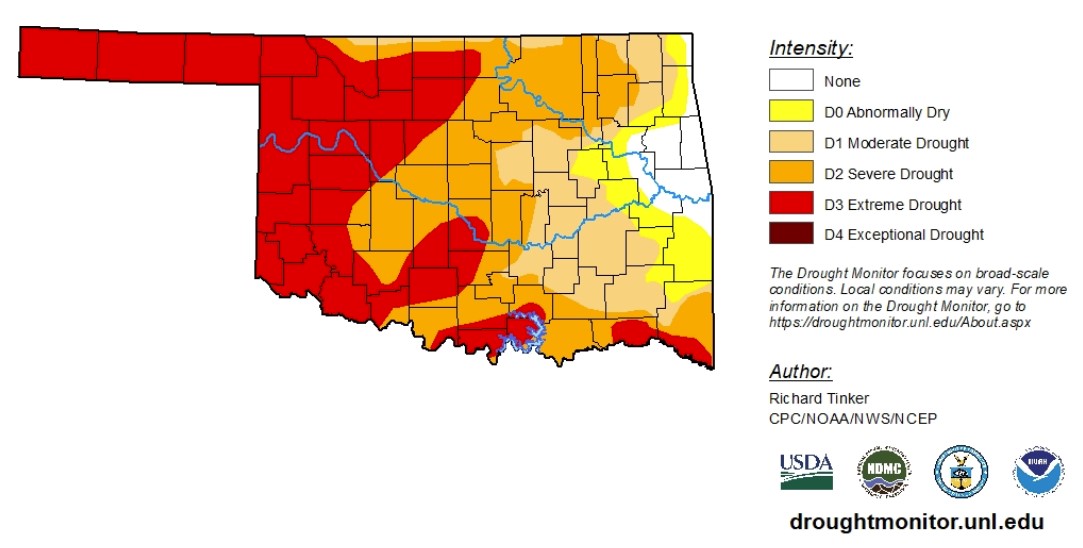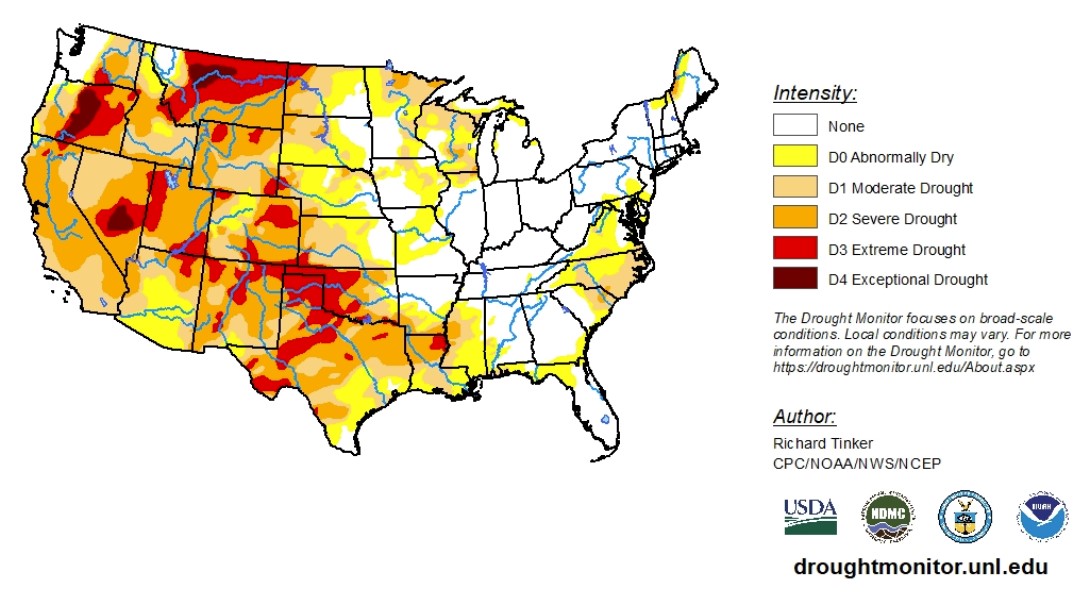
Agricultural News
Drought Monitor Report Shows Drought Conditions Hold Steady
Thu, 13 Jan 2022 14:45:54 CST
 According to the latest U.S. Drought Monitor report, heavy precipitation pelted the northern half of the West Coast again this week. The largest amounts were reported in western Washington and Oregon, where 6 to 10 inches of precipitation fell. Amounts decreased moving southward, with coastal areas and higher elevations from central Oregon to northwestern California receiving 2 to 6 inches of precipitation. Farther east, 2 to 3 inches of precipitation were common across the Idaho Panhandle and the higher elevations farther south and east, including western Wyoming and north-central Colorado. Moderate precipitation - less than an inch - fell on parts of the Pacific Northwest, the northern Intermountain West, and the central and northern Rockies adjacent to areas with higher amounts. Light to locally moderate precipitation dampened portions of the central and northern Great Plains. Elsewhere, little if any precipitation fell, including an area from Oklahoma and Texas westward across much of Nevada and southern California.
According to the latest U.S. Drought Monitor report, heavy precipitation pelted the northern half of the West Coast again this week. The largest amounts were reported in western Washington and Oregon, where 6 to 10 inches of precipitation fell. Amounts decreased moving southward, with coastal areas and higher elevations from central Oregon to northwestern California receiving 2 to 6 inches of precipitation. Farther east, 2 to 3 inches of precipitation were common across the Idaho Panhandle and the higher elevations farther south and east, including western Wyoming and north-central Colorado. Moderate precipitation - less than an inch - fell on parts of the Pacific Northwest, the northern Intermountain West, and the central and northern Rockies adjacent to areas with higher amounts. Light to locally moderate precipitation dampened portions of the central and northern Great Plains. Elsewhere, little if any precipitation fell, including an area from Oklahoma and Texas westward across much of Nevada and southern California.
In the southern Plains, little or no precipitation fell across Oklahoma, western Arkansas and all but easternmost Texas. Heavy precipitation near the southern reaches of the Louisiana/Texas border also prompted some improvement in extreme eastern Texas. Elsewhere, dryness and drought persisted or deteriorated; this region was the only one to experience considerably more deterioration than improvement. Many drought areas increased in coverage across Texas, thus deterioration covered a large proportion of the state.
In the High Plains, Substantial precipitation (over 0.5 inches) was generally restricted to higher-elevation areas in Wyoming and Colorado. Farther east in the Plains States, only the northern and southern portions of the region recorded more than 0.2 inches. Some deterioration was introduced in southern Kansas where temperatures were the highest, but other areas from the Dakotas southward remained unchanged. Heavy precipitation has been common across the higher elevations of central and northern Colorado in the past couple of months. Some of these mountains received several inches more than normal precipitation in the last 90 days, resulting in the abundant snowpack that prompted drought improvement through this region. Other areas were unchanged.
In the West, heavy precipitation affected the Pacific Northwest from the Cascades to the Pacific Coast. Precipitation was greatest in western Washington, where some areas recorded up to 10 inches of precipitation. Lesser but still above-normal amounts pelted central Washington and north-central Oregon. Much of the northern Intermountain West - including most of Idaho and western Montana - reported just under an inch to nearly 3 inches in spots. Further south, an area near the coast as far south as northern California received multiple inches of precipitation, with totals closer to one inch noted in the higher elevations of northern California, including the northern Sierra Nevada. Moderate precipitation also fell on parts of northern Utah. From the Great Basin and central California southward through the southern Rockies - including the southern half of the Four Corners States - most areas received no precipitation. Based on the abundant precipitation and ample snowpack observed so far this winter, improvement was brought into several areas. Most notably, most of the large extreme drought areas covering interior portions of northern and central California were reduced to severe drought. To the northeast, a significant portion of the exceptional drought in southwestern Montana was improved to extreme drought for similar reasons. In addition, smaller areas across central Nevada, southern and eastern Oregon, and some central and southeastern portions of Idaho also saw a significant improvement since the water year began.
To view the Contiguous U.S. Drought Map, click here.
Looking ahead to Jan. 13-17, moderate precipitation of generally 0.5 to 1.0 inches is forecast from central North Dakota southeastward through Iowa and to northern Missouri. Similar totals are expected in the coastal Northwest and the northern half of the Cascades, which will be considerably less than what the region has received for much of the winter. The rest of the 48-states will only see light precipitation at best. Most of the country west of the Appalachians should end up at least somewhat milder than normal for the period, especially from the Great Basin through the northern High Plains and Rockies, where temperatures are expected to average 8 to 16 degrees F above normal.
The Climate Prediction Center's 6-10-day outlook (valid Jan. 18 - 22) slightly favors above-normal precipitation across northern portions of the Rockies and Plains and in the South from the Big Bend of Texas to the Atlantic Coast. In contrast, odds slightly favor below-normal precipitation in a swath from the central Ohio Valley westward into the south-central Plains. Better odds for drier than normal conditions cover much of the Four Corners States, the Great Basin, and much of the West Coast. Areas from the West Coast through the southern half of the Plains and the Lower Mississippi Valley have enhanced chances for above-normal temperatures, but odds favor cooler than normal weather in the northern Plains, Great Lakes Region, Northeast, and the Middle Atlantic States.
To view the 6 - 10 Day Precipitation Outlook, click here.
To view the 6 - 10 Day Temperature Outlook, click here.
According to the Monthly Drought Outlook map, drought conditions should continue to improve from the Pacific Northwest, down into the northern half of California and eastward to western Wyoming, Montana and northern Idaho. Drought conditions are also expected to release California's southern coast and southern Arizona and New Mexico. In the rest of the West and Great Plains, drought conditions are expected to persist and further develop - especially in Texas.
To view the Monthly Drought Outlook map, click here.
Oklahoma
With data ranging between Jan. 5 to 11, drought conditions have not changed much in Oklahoma. After the mass deterioration of drought conditions in the state around Christmas, last week's report showed 40% of the state was classified under extreme drought conditions. In the last week, extreme drought conditions have only increased by 1%.
Right now, 94% of the state is experiencing abnormally dry conditions or worse. Moderate drought conditions are reported in 16% of the state, severe drought conditions are reported in 30% and severe drought conditions are reported in 41%.
A small pocket of eastern Oklahoma continues to fight off drought conditions.
The 6-to-10-day precipitation outlook map shows Oklahoma is likely to receive sub-normal precipitation levels. The 6-to-10-day temperature outlook map shows excessive temperatures are very likely.
To view the Oklahoma drought map, click here.

WebReadyTM Powered by WireReady® NSI
Top Agricultural News
More Headlines...





